[ 1-18 ]|[ 19-37 ]|[ 38-56 ]|[ 57-64 ]

In the assessment of quality of vision, we evaluate the ability to see forms. The most common measurements in clinical examinations are those of form vision, especially visual acuity.
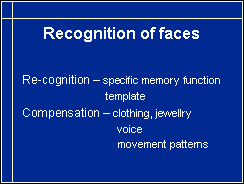
In the life of a preschool child, recognition of geometric forms is less important than recognition of people. Recognition of facial features to recognise a person requires a template in the visual memory and an ability to compare faces of people with the templates. If facial features cannot be recognised, the child needs to learn to use other typical features of persons for recognition.
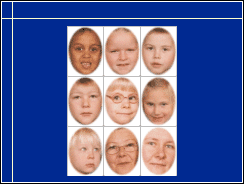
This visual function is rarely totally impaired in young children but it may be severely affected. Like most cortical functions it can be trained if there are even vague signs of ability to recognise facial features.
Matching pictures of faces is a good test and also good training when pictures of peers and neighbours are used as the material. (For more click here.)
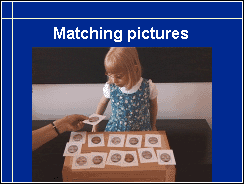
The pictures need to be restricted to the faces because every detail in the pictures will be used for comparison. First the pictures are pairs of pictures that are exactly alike, then several pictures of the same persons with different camera angles and with different expressions.
Motor functions of these children with brain damage are trained in several sessions every week, sensory deficiencies should be equally well assessed and trained. In the assessment we need to evaluate the child's ability to perceive similarities in facial features and to remember them.
These pictures are pictures of peers and teachers of the child in the centre of the collage picture. When they were shown to her and the tester asked "Who are the children and adults in these pictures?" she did not recognise any of them. Then she was helped first by telling that these children she had seen in her kindergarten and when that did not help by telling her that they were her classmates and teachers. Even then she did not recognise them, except herself, because she is the only one who has glasses. - The neuropsychologist testing the girl had received a string of pearls made by the girl when she came to the two day assessment. As long as the neuropsychologist had the pearls, the girl recognised her. When she did not wear them during the last session of the second day, the girl did not know who she was. Nor did she recognise her own occupational therapist when she came to the meeting.
Because of her problem in recognition of people she has been trained to pay attention to all features that could help in recognition. She has also been taught to go to people and say "My name is ..., what is your name." This reminds people of her problem and helps her keep track on who is who.
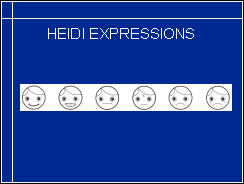
Perceiving expressions is also a specific visual function. We can assess a child's ability to perceive basic facial expressions and the emotional states related to them by playing with the Heidi Expressions Game that consists of pairs of cards with six basic expressions.
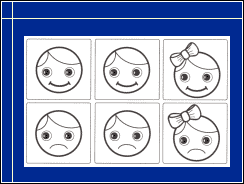
Of each expression there are two cards that are exactly alike and a third where Heidi has a bow. If a child does not see the difference in the expressions (s)he may pick as the similar ones the cards where Heidi has the bow. In that case we accept the choice as correct because of the bow but ask the child to look whether the two faces are alike: "Is Heidi glad or sad in both pictures?"

When matching the pictures of Heidi without the bow the child may not find the pair even among only a few cards. If the child does not seem to understand what we mean with expressions, a thorough study of expressions is needed.
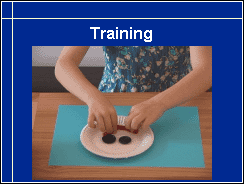
Making visuotactile pictures of faces and comparing them with expressions on the teachers' or peers' faces gives a good opportunity to discuss how expressions look like and what they depict. Also while reading stories, the emotional content of words can be explained and the corresponding expressions performed.
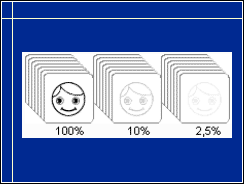
If a child can see the difference between different expressions at full contrast level, pictures at 10% and 2.5% contrast are used to assess recognition at lower contrasts. When contrast sensitivity has decreased, visual communication may be possible only at very short distance. All adults who are involved in the care, teaching or therapies of the child, should know this requirement.
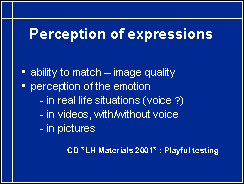
Ability to match black-and-white pictures with expressions on different contrast assesses the quality of the visual image. Although high contrast black-and-white drawings are often easiest to see with impaired visual systems, some children see colour pictures much better and again some other children perceive video images best. Responses to expressions are also observed in real life situations and during small theatre plays that the children create themselves. If the child does not perceive the content of expressions in any of these situations, special teaching program needs to be planned in communication and interaction.

We usually assess the quality of vision by measuring visual acuity with charts at full contrast. Matching is the earliest technique of responding.
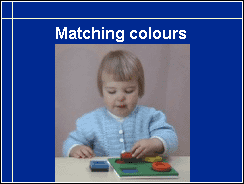
Matching forms is usually a later developing concept than matching colours. Therefore we can teach a child to function in the vision testing situation at a younger than usual age by letting her match colourful forms with cut-outs of same colours.

If a child needs a longer time to train, a computer game on my WebPage gives variation and helps to define whether the child has specific difficulty in seeing forms, either black-and-white or in colour or both.
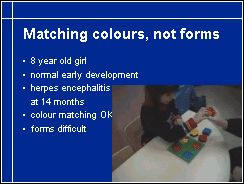
These two functions can be damaged independent from each other as we see in this case: An eight year old girl had no difficulty in placing the colourful puzzle pieces in the corresponding cut-outs but tried to place the black-and-white forms at random. After intensive training she was able to match also the black-and-white forms with single symbols on the Playing Cards so her visual acuity could be measured to be 20/160, with single symbols at near. However, after half an hour she had forgotten the black-and-white forms again, which explains why she had not been able to learn even the first letter of her name. She thus has both poor quality of the visual image and difficulty in transferring the perceived image from working memory to longer time memory functions.
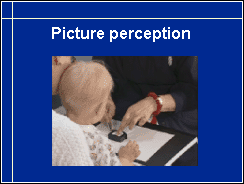
Drawing around objects is an effective way to help a child to understand that the picture represents the object. Picture perception is a prerequisite of testing with optotype tests, tests based on pictures.
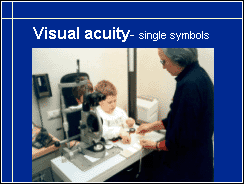
|
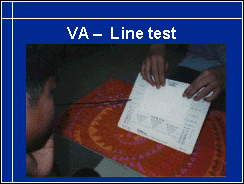
|
| Slide 36. | |
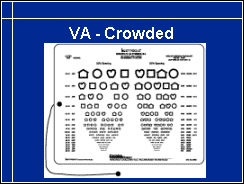
|
|
When the child has learned the forms used in the test, visual acuity can be measured first with single symbols at near, then with the line test and when the child should learn to read, also with symbols with smaller spaces between them, like the crowding of letters in printed texts.
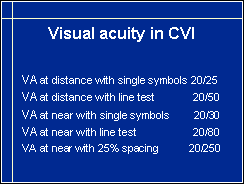
With the crowded test, visual acuity may be much less than visual acuity measured with single symbols. Thus we may ask, what is the visual acuity of a child, whose visual acuity with single symbols at distance is 20/25 and near vision acuity with crowded symbols is 20/250. Functional visual acuity is 20/250 and for example this particular child needs to use closed circuit TV, CCTV, to read regular schoolbooks.